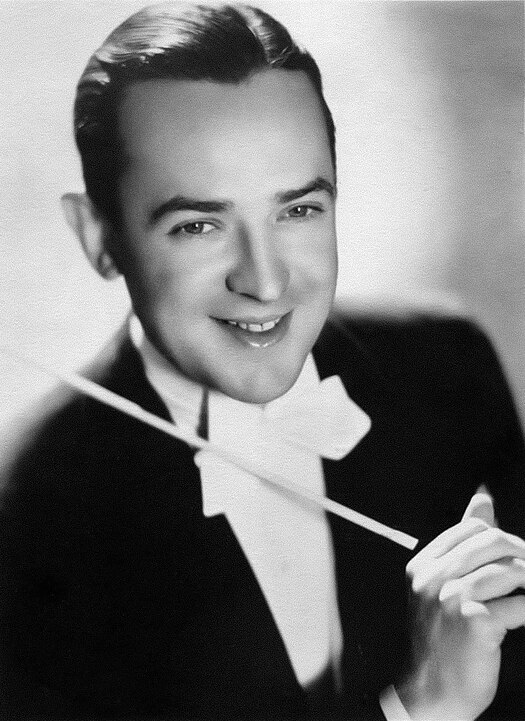Introduction:
Jimmy Dorsey (February 29, 1904 – June 12, 1957) was one of the highly-regarded musicians and big-band leaders during his time, from the 30s up to the 50s music era. Dorsey was proficient in playing the trumpet, clarinet and saxophone. He recorded several pop and jazz standards that have become oldies music classics: : “Is It True What They Say About Dixie?,” “I’m Glad There Is You (In This World of Ordinary People), “It’s the Dreamer in Me,” “Tailspin,” “Change Partners,” “John Silver,” “Amapola,” “Brazil,” and many other hits. Jimmy was the older brother of Tommy Dorsey, who also became a renowned musician of his own right as a trombone player and bandleader. More on Jimmy Dorsey here in this article.
Early life and career
James “Jimmy” Dorsey was born in Shenandoah, Pennsylvania on a Leap Year, in 1904. His brother Tommy, who also became a prominent musician, was born 19 months later. They were the sons of a coal miner who later became a music educator.
Jimmy Dorsey first played the trumpet when he was younger, then later learned to play alto saxophone and then the clarinet. He and brother Tommy formed the Dorsey’s Novelty Six, which went on to become one of the first jazz artists to go on a broadcast.
Throughout the 1920s, he did much recording and radio work; in 1924 he became part of California Ramblers, one of the most popular and prolific jazz groups in the era. In 1930 Jimmy toured much of Europe as member of Ted Lewis’ band. Upon his return to the US, he continued to work with several other bandleaders like Rudy Vallee as well as work with the Dorsey Brothers Orchestra with Tommy.
Making his own name
Chiefly due to Jimmy and Tommy’s musical differences, the former quit the Dorsey Brothers Orchestra in 1935. Not long after the split, Jimmy formed his own band which was named simply as Jimmy Dorsey Orchestra (or Jimmy Dorsey and His Orchestra), which consisted of several members including renowned musicians Bobby Byrne, Ray McKinley, Donald Matteson and Skeets Herfurt.
In 1939 Jimmy chose Helen O’Connell as his female lead vocalist next to the her male counterpart, Bob Eberly. This pairing would bring most of Jimmy and His Orchestra’s biggest hits until O’Connell’s departure in 1942. Other singers like Kay Weber and Kitty Kallen had also sang with the orchestra.
Brief Biography of Helen O’Connell
With a fairly long career, Helen O’Connell was best remembered for screaming in “Green Eyes” and working with Jimmy Dorsey. O’Connell’s sassy looks and charming smile were a big part of her appeal. One journalist likened her adorable dimples to “two quote marks around a happy phrase.” She originally left her native Toledo to perform and tour with her group of Jimmy Richards’ 9 Pieces for a year and a half.
Born in Lima, Ohio, in 1920 and raised in Toledo, O’Connell came from an Irish-American family inclined to music. Her older sister Alice sang in dance bands across Ohio to support her family after her father’s death. When Alice eloped, Helen took over the responsibility. She sang with bands until 1939 when orchestra leader Jimmy Dorsey heard her one night at a club in Greenwich Village and hired her the next day. O’Connell appeared on a regular St. Louis radio show until she agreed to tour with Larry Funk’s band before she was discovered and became the lead vocalist with Jimmy Dorsey in 1938.
O’Connell soon released a hit version of “All of Me,” followed by popular recordings of “Embraceable You,” “Brazil,” “Jim,” and “When the Sun Comes Out.” However, O’Connell became a popular name after she began sharing recordings with balladeer Bob Eberly. Eventually, O’Connell married a naval aviator at the height of her career in 1941 but remained with the band until 1943. She left her career to care for the children while her husband was on duty. Helen O’Connell remained active right up until her death from cancer.
During his lifetime and career Jimmy Dorsey amassed 43 Top 10 hits on the Billboard pop chart, including ten number one’s: “Is It True What They Say About Dixie?” (1934), “Change Partners” (1938), “The Breeze” (1940), “Amapola” (1941), “Green Eyes” (1941), “My Sister and I” (1941), “Maria Elena” (1941), “Blue Champagne” (1941), “Tangerine” (1942) and “Besame Mucho” (1944),
Later life and career
Jimmy continued to lead his own band until the early 50s. He and Tommy had settled their past differences, and this led to Jimmy joining his brother’s orchestra which was later renamed as “Tommy Dorsey and his Orch. featuring Jimmy Dorsey.” The brothers would often perform together, and their successful stint on Jackie Gleason’s TV program led them to host their own TV program Stage Show (1954-1956).
The brothers’ careers were still pretty much at their peak during this time. However, Tommy died unexpectedly in November 1956 due to an accidental choking during his sleep. Jimmy took the helm as a new bandleader after Tommy’s death.
A mere number of months after Tommy died, Jimmy himself succumbed to throat cancer on June 12, 1957 in New York City. He was 53 years old. The brothers’ early demise signaled the end of the Dorsey era.
Shortly before his death, Jimmy received a gold record for the single “So Rare,” which entered the chart in February 1957 later went all the way to #2.

